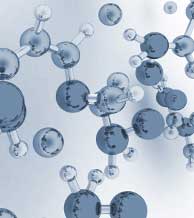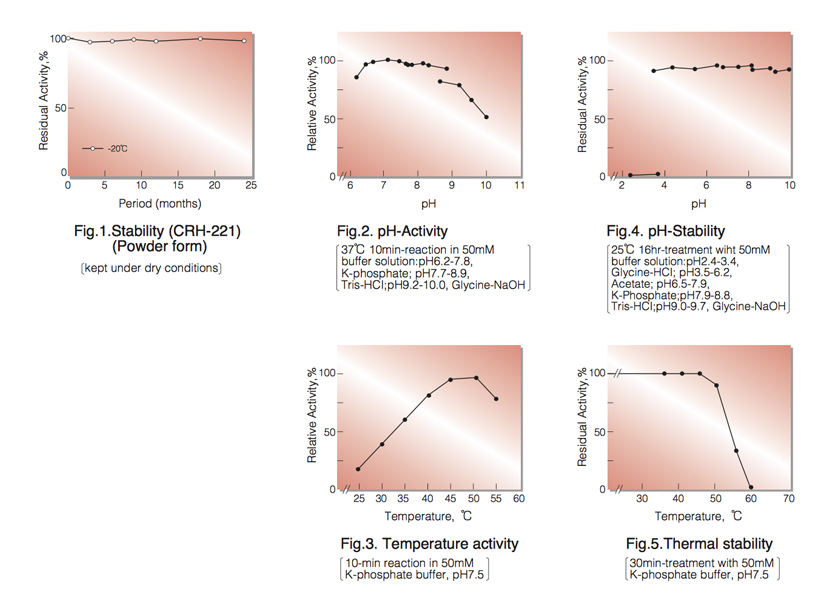CREATINE AMIDINOHYDROLASE from Microorganism
CRH-221, 229
| Appearance: | (-221) White amorphous powder, lyophilized (-229) Clear solution |
|
|---|---|---|
| Activity: | GradeⅡ (-221) 4.0U/mg-solid or more (-229) 2000U/ml or more |
|
| Contaminants: | NADH oxidase ≤5.0×10⁻²% Catalase ≤2.0% |
|
| Stabilizers: | Sugars, EDTA | |
| Stability: | (-221) Stable at -20°C for at least One year (Fig.1) |
|---|---|
| (-229) Stable at 4°C | |
| Molecular weight: | approx. 67,000 (by gel filtration) |
| Structure: | 2 subunits per enzyme molecule |
| Isoelectric point: | 4.5±0.1 |
| Michaelis constant: | 4.5×10⁻³ M (Creatine) |
| Inhibitors: | Hg⁺⁺, Cu⁺⁺, Ag⁺, SH reagent (NEM), PCMB |
| Optimum pH: | 6.5-7.5(Fig.2) |
| Optimum temperature: | 40-50℃(Fig.3) |
| pH Stability: | pH 4.0-10.0 (25℃, 20hr)(Fig.4) |
| Thermal stability: | below 50℃ (pH 7.5, 30min)(Fig.5) |
| Effect of various chemicals: | (Table 1) |
APPLICATIONS
This enzyme is useful for enzymatic determination of creatine and creatinine when coupled with creatinine amidohydrolase (CNH-211, CNH-311) and sarcosine oxidase (SAO-351) in clinical analysis.
ASSAY
Principle:

The appearance of yellow dye formed by condensation of urea and p-dimethylaminobenzaldehyde (DAB) (Ehrlich reaction) is measured at 435nm by spectrophotometry.
Unit definition:
One unit causes the formation of one micromole of yellow dye per minute under the conditions described below.
Method:
| A. Creatine solution: | 0.1M[1.49g creatine (Nacalai tesque)/100ml of 50mM phosphate buffer, pH 7.5] (Prepare freshly) |
|---|---|
| B. DAB solution: | Dissolve 2.0g of DAB in 100ml of dimethylsulfoxide and, to this solution, add 15ml of conc. HCl solution. |
| C. Enzyme diluent: | 50mM Phosphate buffer, pH 7.5 |
Procedure
| Concentration in assay mixture | |
|---|---|
| Phosphate buffer | 50mM |
| Creatine | 90mM |
1. Pipette 1.0ml of the substrate solution (A) into a test tube and equilibrate at 37℃ for about 5 minutes.
2. Add 0.1ml of the enzyme solution* and mix.
3. After exactly 10 minutes at 37℃, add 2.0ml of DAB solution (B) to stop the reaction.
4. Incubate at 25℃ for 20 minutes.
5. Measure the optical density at 435nm against water (OD test).
At the same time, prepare the blank by first mixing the substrate solution with 2.0ml of DAB solution after a 10 min-incubation at 37℃, followed by the addition of the enzyme solution, and carry out the same procedure as test (procedure 4 and 5)(OD blank).
* Dissolve the enzyme preparation in ice-cold enzyme diluent (C) and dilute to 2.0-3.0 U/ml with the same buffer, immediately before assay.
Calculation
Activity can be calculated by using the following formula :

ΔOD (OD test−OD blank ) × Vt × df
Volume activity (U/ml) = =ΔOD×9.65×df
0.321×1.0× t ×Vs
Weight activity (U/mg) = (U/ml) × 1/C
- Vt
- : Total volume (3.1ml)
- Vs
- : Sample volume (0.1ml)
- 0.321
- : Millimolar extinction coefficient of yellow dye(㎠/micromole)
- 1.0
- : Light path length (cm)
- t
- : Reaction time (10 minutes)
- df
- : Dilution factor
- C
- : Enzyme concentration in dissolution (c mg/ml)
REFERENCES
- D.Tsuru; Nucleic Acid and Amino Acids, 35, 31 (1977).
- T.Yoshimoto, I.Oka and D.Tsuru; Arch.Biochem.Biophys., 177, 508 (1976).
- T.Yoshimoto ,I.Oka and D.Tsuru; J.Biochem., 79, 1381 (1976).
- D.Tsuru; Rinsho Kensa, 22, 1331 (1978).
| Chemical | Concn.(mM) | Residual activity(%) |
Chemical | Concn.(mM) | Residual activity(%) |
|---|---|---|---|---|---|
| None | − | 100 | NaF | 1.0 | 99 |
| Metal salt | 1.0 | PCMB | 0.33 | 0 | |
| CaCl₂ |
102 | MIA | 1.0 | 94 | |
| MnCl₂ | 96 | IAA | 1.0 | 100 | |
| MgCl₂ | 103 | NaN₃ | 10 | 96 | |
| NiCl₂ | 104 | o-Phenanthroline | 1.0 | 99 | |
| CoCl₂ | 104 | Hydroxylamine | 1.0 | 99 | |
| Ba(OAc)₂ | 98 | NEM | 10 | 32 | |
| Cd(OAc)₂ | 98 | Triton X-100 | 0.5% | 99 | |
| FeCl₃ | 89 | Brij 35 | 0.5% | 94 | |
| FeSO₄ | 81 | Tween 20 | 0.5% | 98 | |
| HgCl₂ | 0 | Span 20 | 0.5% | 99 | |
| ZnSO₄ | 63 | Na-cholate | 0.25% | 96 | |
| CuSO₄ | 0 | SDS | 0.25% | 32 | |
| Pb(OAc)₂ | 98 | DAC | 0.5% | 0 | |
| AgNO₃ | 0 | ||||
| EDTA | 20 | 98 | |||
| α,α′-Dipyridyl | 1.0 | 102 |
Ac, CH₃CO; PCMB, P-Chloromercuribenzoate; MIA, Monoidoacetate; EDTA, Ethylenediaminetetraacetate; IAA, lodoacetamide; NEM, N-Ethylmaleimide; SDS, Sodium dodecyl sulfate; DAC, Dimethylbenzlyalkylammonium chloride.

To get a quote, contact us at info@toyobousa.com, or INQUIRY.
